|
|
|
Sort Order |
|
|
|
Items / Page
|
|
|
|
|
|
|
| Srl | Item |
| 1 |
ID:
175503
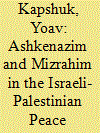

|
|
|
|
|
| Summary/Abstract |
This paper examines the mechanisms which drive the different political attitudes of Israel’s two major Jewish groups – the Ashkenazim and the Mizrahim – vis-à-vis the Israeli-Palestinian peace process in the 1990s. The study argues that the economic liberalization reforms of the 1980s along with the subsequent Israel’s integration with the global economy are key drivers of the two groups’ opposing attitudes vis-à-vis the peace process. These processes benefited mainly the business classes, who are dominated by the Ashkenazim (originating from Europe). It was such benefit that drove Ashkenazim’s support for the Oslo Accords in the 1990s, which was seen as instrumental to the process of Israel’s integration with the global economy. Conversely, the same economic processes likely hurt lower-class members of Israeli Jewish society, most of whom are Mizrahim (originating from Muslim countries). In this context the settlements in the West Bank and Gaza provided them with an alternative source of welfare to buffer the negative impacts of the integration process. As a result most of the Mizrahim population opposed any peace deal that included the evacuation of settlements. Moreover, Mizrahim’s opposition to Oslo was strengthened by the association of Oslo with Israel’s global integration, which some evidence suggests mainly benefited the business classes.
|
|
|
|
|
|
|
|
|
|
|
|
|
|
|
|
| 2 |
ID:
175507


|
|
|
|
|
| Summary/Abstract |
Local labor market adjustment to exogenous demand changes is studied in the context of the closure of U.S. military bases between 1991 and 1999. This post Cold War episode provides for a natural experiment with evidence to inform policy on the labor market impact of defense spending cycles. The results are consistent with both search and declining sector wage rigidity increasing adjustment costs and are generally not consistent with market intervention theories of long duration unemployment.
|
|
|
|
|
|
|
|
|
|
|
|
|
|
|
|
| 3 |
ID:
175506
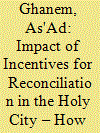

|
|
|
|
|
| Summary/Abstract |
This article analyses the implications of international aid for the failure of Palestinian-Israeli reconciliation in Jerusalem. Donors were motivated to contribute to efforts to reach a sustainable Palestinian-Israeli peace to be based on Israeli withdrawal to the 1967 borders and the establishment of a Palestinian state with East Jerusalem as its capital. In this article the main argument is that in practice, due to political considerations, international aid at least partially harmed the peace process and helped Israel enhance its control over East Jerusalem and harmed the efforts to reach a reconciliation in the holy city.
|
|
|
|
|
|
|
|
|
|
|
|
|
|
|
|
| 4 |
ID:
175500
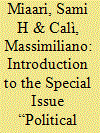

|
|
|
|
|
| Summary/Abstract |
The Israeli-Palestinian conflict is the world’s most protracted contemporary conflict and one which has gained international prominence throughout the years. As a result of the Six Days War in 1967, the West Bank and the Gaza Strip fell under Israeli control. The conflict has evolved through ebbs and flows of violence including two Palestinian uprising against Israeli control (the First and Second Intifada). These have led to tens of thousands of Palestinian and thousands of Israeli victims.
|
|
|
|
|
|
|
|
|
|
|
|
|
|
|
|
| 5 |
ID:
175504


|
|
|
|
|
| Summary/Abstract |
This paper studies the gender wage differential in the Palestinian labor market of the West Bank before, during, and in the aftermath of the second Intifada. We combine data on the Palestinian labor force, politically motivated fatalities of Palestinians, and movement restrictions in the West Bank, in order to quantify the effect of political violence on the gender wage gap. We find that political violence during the second Intifada decreased the gender wage gap. We also observe a long-term trend of more women entering the labor force, especially in middle-income occupations where there is an existing large share of female employees. Political violence did not seem to reverse or hurt that trend. We provide suggestive evidence that the reduction in the wage gap is due to the increased supply of low-skilled men, who previously worked in Israel and entered the local labor market due to the Intifada.
|
|
|
|
|
|
|
|
|
|
|
|
|
|
|
|
| 6 |
ID:
175505
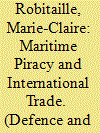

|
|
|
|
|
| Summary/Abstract |
Maritime piracy is a serious threat to international trade. Indeed, using Instrumental Variable Poisson Pseudo-Maximum Likelihood (IV-PPML) and PPML gravity models and using data on maritime distance and on piracy attacks over the period 2000–2016, it is estimated that an increase by 10 piracy attacks on the shortest maritime trade route between a country-pair results in a decrease in bilateral trade’s value by 2.8%. The impact, at 1.5%, is much smaller if the endogeneity of piracy attacks is not controlled for. Heterogeneity analysis reveals that successful attacks, attacks that involve violence, or attacks that target cargo are particularly detrimental to trade. This paper contributes to the literature by being the first to look at: non-Somali piracy attacks, different commodity groups, and various forms of attacks. This paper also proposes the use of maritime distance, instead of the commonly used great-circle distance. Finally, it offers a new instrumental variable for piracy attacks, namely, the sum of the square of the highest security apparatus index among countries in the vicinity of each vital chokepoint crossed by a ship travelling on the shortest maritime trade route between a country-pair, in a given year.
|
|
|
|
|
|
|
|
|
|
|
|
|
|
|
|
| 7 |
ID:
175501
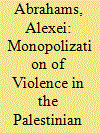

|
|
|
|
|
| Summary/Abstract |
Palestinians currently find themselves involved in two conflicts: an external one with the state of Israel, and an internal one with the leadership of the Palestinian national movement itself. In this essay, we argue that violence is overly monopolized in both conflicts. Firstly, Israel can safely ignore the peace process and renege on political concessions as long as Palestinians lack a credible militant threat. This threat, in turn, has been neutralized in large part by the Palestinian Authority (PA) itself, which has offered Israel increasingly effective security cooperation over the past decade. We argue that the PA’s decision to deepen security cooperation with Israel – in spite of its unpopularity among Palestinians – results from its own territorial monopolies on violence, which render it unaccountable to its constituents. Only by reintroducing a credible, latent threat of political-militant competitors to the PA will Palestinians be able to regain bargaining leverage over their own leadership, restore conditionality to their security cooperation with Israel, and put the peace process back on course.
|
|
|
|
|
|
|
|
|
|
|
|
|
|
|
|
| 8 |
ID:
175502


|
|
|
|
|
| Summary/Abstract |
In this paper, we analyze the Israeli-Palestinian conflict by proposing a proxy war model, where conflict lasts longer, but it is less costly than direct military confrontation. In proxy wars, Nash equilibria are realizable, but not always sustainable in the long-run. The consolidation level of the double principal–agent relationship predicts the continuation of conflict and thus the emergence of peace. As our model suggests, the Israeli-Palestinian conflict is likely to remain irresolvable, as long as the Palestinians do not have a principal that is willing to provide continuous and positive levels of conflict involvement.
|
|
|
|
|
|
|
|
|
|
|
|
|
|
|
|
| 9 |
ID:
175508
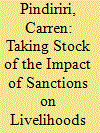

|
|
|
|
|
| Summary/Abstract |
This article draws on the established empirical literature to assess the impact of United States sanctions on livelihoods and poverty in Zimbabwe. Using time-series data spanning from 1980 to 2015, the findings from a linear specification in sanctions duration show no evidence to support the negative impact of sanctions on formal employment and poverty. The results, however, portray a quadratic relationship between sanctions duration and livelihoods. Sanctions reduced formal employment during the initial stages but the negative relationship changed over time. Subsequently, informality increased during the sanctions period. Similarly, the relationship between sanctions duration and poverty is also non-linear. The turning point of the poverty quadratic curve coincides with the implementation of indigenization policy. Indigenization policy magnified sanctions’ negative impact instead of offsetting the impact. In this view, the government should consider addressing the indigenization policy which it has control over while at the same time continue re-engaging USA for the removal of sanctions.
|
|
|
|
|
|
|
|
|
|
|
|
|
|
|
|
|
|
|
|
|